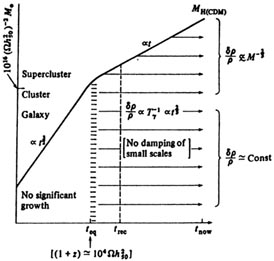


Clusters can be observed at sufficiently large redshifts that evolutionary effects are expected. Indeed, an exciting recent result is the discovery that the X-ray emission from clusters is increasing with cosmic time, even in a sample restricted to redshifts less than about 0.5. This discovery is qualitatively consistent with the expectations of hierarchical models, according to which big clusters would have formed only recently as the outcome of mergers of smaller ones. And it has stimulated further discussion of cluster formation, particularly in the context of specific models.
The most popular and best-defined cosmogonic model is the standard Cold Dark
Matter scheme. On the assumption that the fluctuations have the same r.m.s.
amplitude on all scales when that scale enters the horizon (the
'Harrison-Zeldovich'
spectrum), one can then calculate the r.m.s. fluctuations at the
recombination epoch
as a function of mass scale M. See
Figure 3 and its caption for
more explanation. On the further assumption that the amplitude
distribution is gaussian, one can set
up initial conditions for an N-body simulation which can compute the
distribution
of the dark matter as a function of cosmic epoch. Work of this kind
leads to good
quantitative agreement with the properties of individual galactic halos
and small
groups. Moreover, rich clusters can be interpreted as the outcome of
exceptionally
high amplitude peaks in the initial noise distribution on mass scales of order
1015 M .
.

|
Figure 3. The growth of adiabatic
fluctuations in a universe dominated by 'cold dark matter'.
The mass of cold dark matter within the particle horizon is shown as a
function of
time on a log-log plot. For t > teq
(corresponding to the redshift indicated on the figure),
all scales grow at the same rate. Before teq, when the
expansion is radiation-dominated,
there is essentially no growth, because the growth timescale much
exceeds the expansion
timescale. If the fluctuations on all scales enter the horizon with
equal amplitude (the
'Harrison-Zeldovich' hypothesis), then the present-day spectrum would
have the approximate
form written on the right-hand side. The cold dark matter perturbations
start to
grow at teq, whereas radiation pressure inhibits
growth of baryonic fluctuations on relevant
scales until the (later) recombination time trec. Cold
dark matter fluctuations thus have
a 'head start' (baryons being able to fall into the resultant potential
well after trec); this
permits an acceptable cosmogonic scheme with lower fluctuation amplitude
|
It is of course the baryons, particularly the hot gas and the galaxies themselves, which are directly observed, so what is really needed is a simulation which takes account of how the gas evolves, and how it condenses into galaxies. This is a much more challenging computational task, where, as we will hear at this meeting, the first steps are now being taken. However, even without detailed calculations, the CDM model can give a convincing answer to a question which arises in any hierarchical model: namely, what determines the demarcation between an individual galaxy and a cluster? Why is something like the Coma cluster not just a single big galaxy?
The answer to this question depends crucially on the cooling time for
gas trapped
in a potential well. If this is short compared to the dynamical time, no
quasi-static
equilibrium is possible, and the gas will fragment into stars, perhaps
alter collapsing
to a disc. If the cooling is slower than free fall, but still can occur
within the Hubble
time, then the gas, though quasi-static, will gradually deflate towards
the centre
of the potential well. If the cooling is slower still, the shock-heated
gas in effect
remains at the virial temperature. These three regimes are depicted in
Figure 4, in
a plot of mass versus radius. From this figure, we can see why there is
an upper
limit to the mass of galaxies. In a hierarchical build up of structure,
as in the CDM
model, the bound systems at early epochs are dense, and the potential wells are
shallow enough that the gas does not get heated to a very high temperature. In
these situations, cooling is rapid and effective. But beyond a certain
stage, when
the potential wells are deeper and the density lower, cooling is less
effective. The critical mass, of order 1012
M , therefore sets an
upper limit to the size of a galaxy.
If larger aggregates build up by gravitational clustering, the gas
within them will
remain hot. This is essentially the distinction between a large galaxy
and a system such as
Coma.
, therefore sets an
upper limit to the size of a galaxy.
If larger aggregates build up by gravitational clustering, the gas
within them will
remain hot. This is essentially the distinction between a large galaxy
and a system such as
Coma.